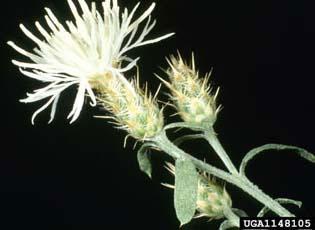Centaurea diffusa Lam. (ITIS)
Diffuse knapweed, white knapweed, spreading knapweed, tumble knapweed
Acosta diffusa (Lam.) (ITIS)
Eastern Mediterranean region (Winston et al. 2012)
1800s (Wolfson et al. 2005)
Introduced accidentally through contaminated seed (Zouhar 2001)
Reduces agricultural yields and forage values; crowds out native species (Winston et al. 2012)

Diffuse knapweed, flowers
USDA APHIS PPQ, Oxford, North Carolina
Find more images
Distribution / Maps / Survey Status
Videos
All Resources
Selected Resources
The section below contains highly relevant resources for this species, organized by source.
Council or Task Force
Partnership
Federal Government
State and Local Government
Academic
Integrated Taxonomic Information System. Centaurea diffusa. [Accessed Aug 27, 2023].
Winston, R., M. Schwarzlander, C.B. Randall, and R. Reardon. 2012. Biology and biological control of knapweeds [PDF, 45.4 MB] (FHTET-2011-05) U.S. Forest Service Forest Health Technology Enterprise Team.
Wolfson, B.A., T.E. Kolb, C.H. Sieg, and K.M. Clancy. 2005. Effects of post-fire conditions on germination and seedling success of diffuse knapweed in northern Arizona. Forest Ecology and Management 216(1-3):342-358.
Zouhar, K. 2001. Centaurea diffusa. In: Fire Effects Information System. U.S. Department of Agriculture, Forest Service, Rocky Mountain Research Station, Fire Sciences Laboratory.
